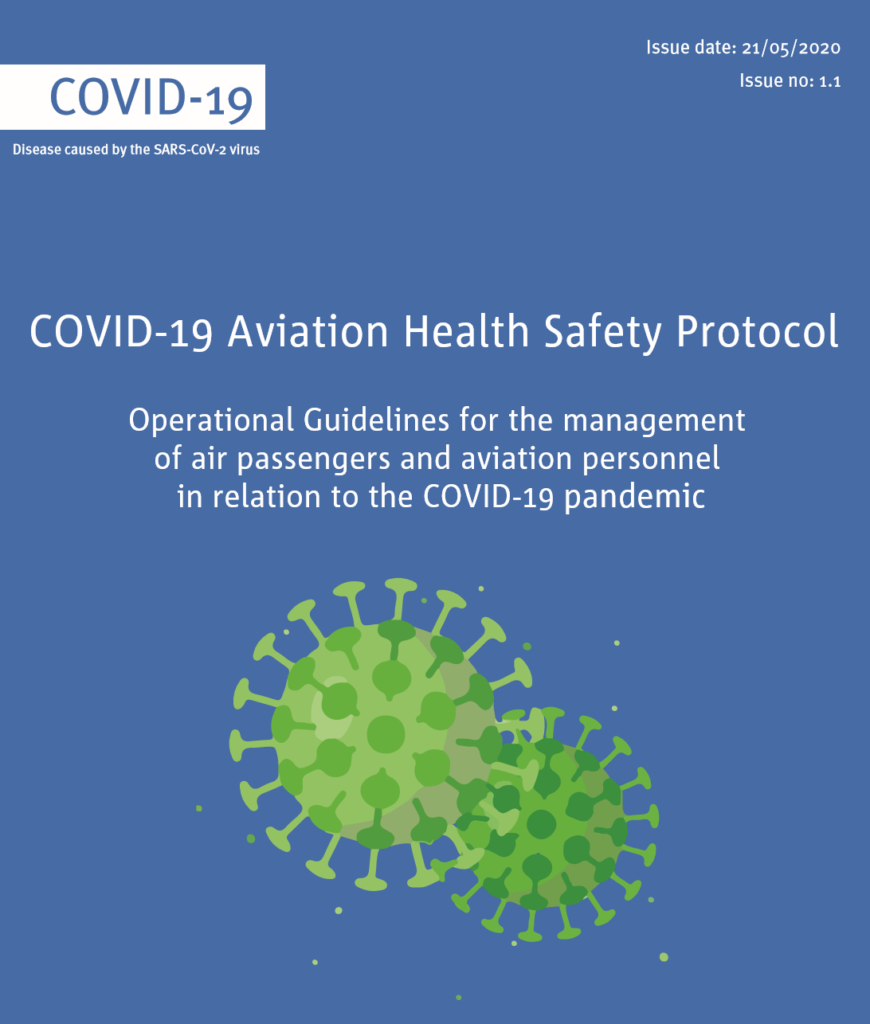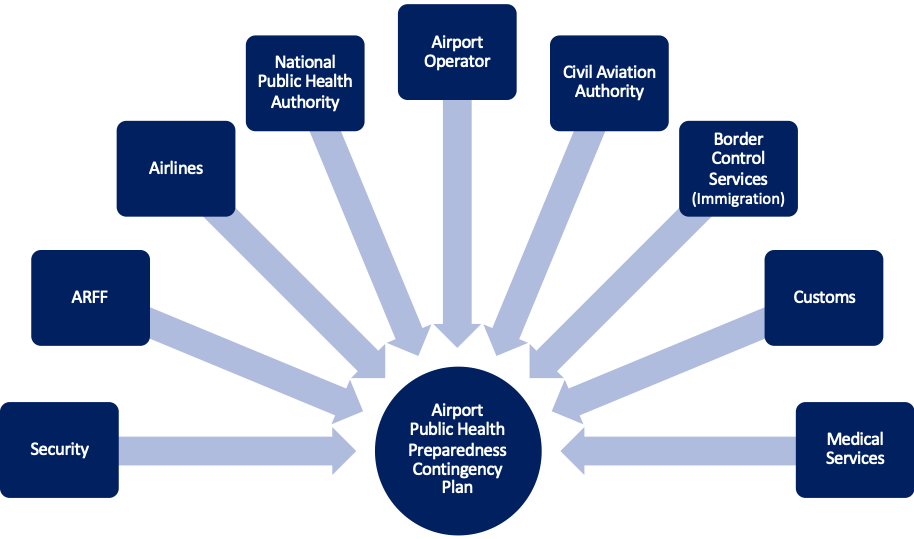COVID-HQ: Operationalizing New Aviation Health Requirements in the Age of Coronavirus (Part 1 of 2)
Fernando Lopez-Calleja
Adriana Boza
June 10, 2020

The ongoing COVID-19 pandemic has had a significant and long-lasting impact onto the aviation industry, and airport operations in particular. As the industry starts preparing for a long and progressive recovery, airport operators (and the aviation industry as a whole) are faced with a new regulatory set of requirements and guidelines: Aviation Health. It is now apparent that the risk of COVID-19 infection will continue for some considerable time in as the development of a successful vaccine cannot be achieved in a matter of weeks – if it can be achieved at all. As such, the recovery of passenger traffic at airports worldwide will need to be achieved in the context of providing adequate health protection – as well as confidence in the health measures adopted – to both the passenger and staff communities. While the scope of such measures remains in flux as clear Aviation Health requirements are set, the ICAO Council Aviation Recovery Task Force (CART) provides a useful overview in its “Take-Off Guidance”.  Source: ICAO The introduction of Aviation Health requirements onto the existing airport operation should not be taken lightly. While initial measures may have focused on relatively small elements associated with social distancing or facility cleaning, implementing a comprehensive and resilient approach to Aviation Health could be in time comparable to complying with Aerodrome Safety or Airport Security requirements – and is likely to require the development of a new Operating Model and Concept of Operations that integrates Aviation Health within the airport operation. As such, airports should consider the Aviation Health requirements in terms of People, Process, Systems, Tools & Equipment and Infrastructure – as well the overarching Authorities & Governance considerations to manage the delivery of these new requirements. Mapping out how the airport intends to map these requirements against these core areas would allow their integration with existing operational approaches to Safety, Security or Passenger Experience.
Source: ICAO The introduction of Aviation Health requirements onto the existing airport operation should not be taken lightly. While initial measures may have focused on relatively small elements associated with social distancing or facility cleaning, implementing a comprehensive and resilient approach to Aviation Health could be in time comparable to complying with Aerodrome Safety or Airport Security requirements – and is likely to require the development of a new Operating Model and Concept of Operations that integrates Aviation Health within the airport operation. As such, airports should consider the Aviation Health requirements in terms of People, Process, Systems, Tools & Equipment and Infrastructure – as well the overarching Authorities & Governance considerations to manage the delivery of these new requirements. Mapping out how the airport intends to map these requirements against these core areas would allow their integration with existing operational approaches to Safety, Security or Passenger Experience.  Source: ICAO Regulatory Landscape The regulatory landscape in terms of Aviation Health requirements remains complex. Firstly, the World Health Organization (WHO) establishes in the International Health Regulations (IHR) the framework to manage and control the international spread of disease, including the general requirements for airports, ports and land crossings. National Public Health Authorities establish their own regulations based on the international directives issued by WHO and the local policies. Aviation Health requirements are driven by National Public Health Authorities, and as such requirements are likely to be based on local, rather than global policy: an overarching international set of consistent requirements, such as those set by ICAO on Safety or Security are highly unlikely to be achieved within the next year or two. Secondly, while guidance material has been provided by ICAO (CART Take-Off Guidance) or EASA (of note is its COVID-19 Aviation Health Guidelines ), and industry bodies such as IATA or ACI (including process streamlining initiatives such as the One-Stop Security Concept – https://store.aci.aero/form/one-stop-security-toolkit/), in the main a clear and definitive set of requirements remains in development and subject to change and update for the next few months. Airports, at present, are having to adapt to an ongoing changing environment. Facing the Challenges A team effort is required to face this critical point in aviation history. A close coordination between the Airport Operator, the National Public Health Authority and other airport stakeholders is needed. A collaborative effort should be made to develop protocols and procedures to maintain optimum safety levels to passengers and staff and to mitigate the risk of contagion of a disease declared as a Public Health Emergency of International Concern. These protocols, procedures and communication strategies should be included in the Airport Public Health Preparedness Plan. The responsibilities of each agency involved in the response of a public health emergency should be clearly defined. This plan should be scalable, so that it could be extended or reduced according to the disease threat level.
Source: ICAO Regulatory Landscape The regulatory landscape in terms of Aviation Health requirements remains complex. Firstly, the World Health Organization (WHO) establishes in the International Health Regulations (IHR) the framework to manage and control the international spread of disease, including the general requirements for airports, ports and land crossings. National Public Health Authorities establish their own regulations based on the international directives issued by WHO and the local policies. Aviation Health requirements are driven by National Public Health Authorities, and as such requirements are likely to be based on local, rather than global policy: an overarching international set of consistent requirements, such as those set by ICAO on Safety or Security are highly unlikely to be achieved within the next year or two. Secondly, while guidance material has been provided by ICAO (CART Take-Off Guidance) or EASA (of note is its COVID-19 Aviation Health Guidelines ), and industry bodies such as IATA or ACI (including process streamlining initiatives such as the One-Stop Security Concept – https://store.aci.aero/form/one-stop-security-toolkit/), in the main a clear and definitive set of requirements remains in development and subject to change and update for the next few months. Airports, at present, are having to adapt to an ongoing changing environment. Facing the Challenges A team effort is required to face this critical point in aviation history. A close coordination between the Airport Operator, the National Public Health Authority and other airport stakeholders is needed. A collaborative effort should be made to develop protocols and procedures to maintain optimum safety levels to passengers and staff and to mitigate the risk of contagion of a disease declared as a Public Health Emergency of International Concern. These protocols, procedures and communication strategies should be included in the Airport Public Health Preparedness Plan. The responsibilities of each agency involved in the response of a public health emergency should be clearly defined. This plan should be scalable, so that it could be extended or reduced according to the disease threat level.  Similar to the Airport Emergency Response Plan, the Airport Public Health Preparedness Contingency Plan should be practiced and tested, to make sure that protocols are up-to-date and effective. Also, those practices are fundamental to improve coordination and relationships between the various agencies and stakeholders at the airport and identify key aspects that require improvement. Of special interest is the validation of the communication strategy and plan, with emphasis in the lines of communication, which are key in the attention of an emergency.
Similar to the Airport Emergency Response Plan, the Airport Public Health Preparedness Contingency Plan should be practiced and tested, to make sure that protocols are up-to-date and effective. Also, those practices are fundamental to improve coordination and relationships between the various agencies and stakeholders at the airport and identify key aspects that require improvement. Of special interest is the validation of the communication strategy and plan, with emphasis in the lines of communication, which are key in the attention of an emergency.  Source: Modalis/airportQM – Airport stakeholder’s input into the Airport Public Health Preparedness Contingency Plan. Impacts to Airport Operations Airport Operations are enduring significant impacts. New protocols and processes must be implemented in order to ensure that the Aviation Health requirements are met, while at the same time, maintaining the levels of safety and security and delivering a good passenger experience to the traveller. As part of the new operating model for airports, Aviation Health requirements should be considered across all aspects of the airport operations model, and can be described in terms of Authorities, People, Process, Technology (Systems, Tools & Equipment) and Infrastructure. These areas would be explored in detail within the second part of our article. (This is part 1 of a 2-part series. Part 2 can be found here). Adriana Boza and Fernando Lopez-Calleja are part of airportQM by Modalis (www.airportQM.com), which provides audit, assessment, regulatory oversight and advice, ORAT and operational improvements to airports worldwide.
Source: Modalis/airportQM – Airport stakeholder’s input into the Airport Public Health Preparedness Contingency Plan. Impacts to Airport Operations Airport Operations are enduring significant impacts. New protocols and processes must be implemented in order to ensure that the Aviation Health requirements are met, while at the same time, maintaining the levels of safety and security and delivering a good passenger experience to the traveller. As part of the new operating model for airports, Aviation Health requirements should be considered across all aspects of the airport operations model, and can be described in terms of Authorities, People, Process, Technology (Systems, Tools & Equipment) and Infrastructure. These areas would be explored in detail within the second part of our article. (This is part 1 of a 2-part series. Part 2 can be found here). Adriana Boza and Fernando Lopez-Calleja are part of airportQM by Modalis (www.airportQM.com), which provides audit, assessment, regulatory oversight and advice, ORAT and operational improvements to airports worldwide.
